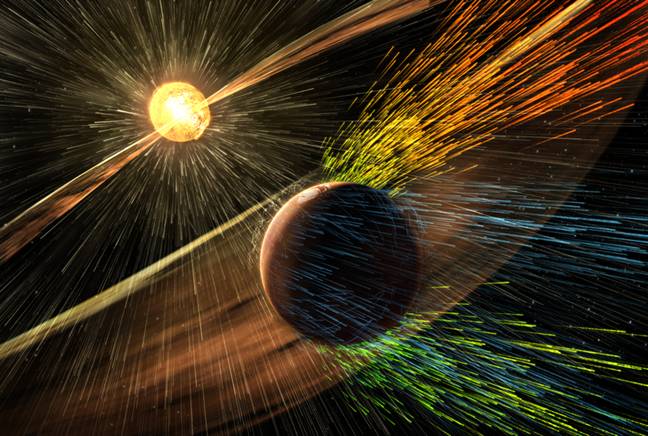NASA’s MAVEN (Mars Atmosphere and Volatile Evolution) mission has observed an abrupt and dramatic drop in the solar wind, resulting in an expansion of the Martian atmosphere and magnetosphere by thousands of kilometers.
Artist’s rendering of a solar storm hitting Mars and stripping ions from the planet’s upper atmosphere – Click to enlarge Credits: NASA/GSFC
The event occurred in December 2022 during a period of increased solar activity. A much more powerful solar wind was emitted from the Sun, which overtook the slower-moving solar wind. The two regions were compressed together, and a void of very low-density solar wind was left in its wake.
According to NASA, “This ‘disappearance’ of the solar wind led to some incredible interactions within Mars’ magnetosphere and ionosphere.”
The density of the solar wind dropped by a factor of 100, which caused a drop of pressure and a more than tripling in the size of the magnetosphere and ionosphere of the planet. Scientists described the size of the drop as “almost unbelievable.”
The solar wind is the stream of charged particles spat out by the Sun. It hits all planets in the solar system. The stream is diverted by a magnetosphere – something the Earth, Mercury, Saturn, Jupiter, Uranus, and Neptune have, while Mars lacks one strong enough to prevent the solar wind from stripping its atmosphere.
“The Sun’s magnetic field that typically is embedded within the Martian ionosphere was pushed outwards,” explained NASA, “which transformed the ionosphere from a magnetized to unmagnetized state. At the same time, the layer between the solar wind and the magnetosphere became unusually electromagnetically quiet.”
MAVEN is in the unique position of being the only Mars spacecraft able to observe both the Sun’s activity and the response of the Martian atmosphere.
Scientists hope the observations gathered during the event will help them better understand the physics behind water and atmospheric loss at Mars.
“We are really getting to see how Mars responds when the solar wind is effectively removed,” enthused Jasper Halekas, professor at the University of Iowa and the lead author on a new study on the event. “It makes for a great outlier study on what Mars would be like if it were orbiting a less ‘windy’ star.”
MAVEN was launched just over ten years ago. Its mission is to study the atmosphere of Mars, and its longevity has proven to be a boon for scientists. As the Sun approaches the solar maximum – the peak of its 11-year activity cycle – the likelihood of another extreme solar event that the orbiter can observe increases.
“Observing extreme conditions is always scientifically invaluable,” noted Shannon Curry, principal investigator for MAVEN at the University of California, Berkeley. “MAVEN was designed to observe these types of interactions between the Sun and the Martian atmosphere, and the spacecraft provided exceptional data during this truly anomalous solar event.” ®

Dr. Thomas Hughes is a UK-based scientist and science communicator who makes complex topics accessible to readers. His articles explore breakthroughs in various scientific disciplines, from space exploration to cutting-edge research.








